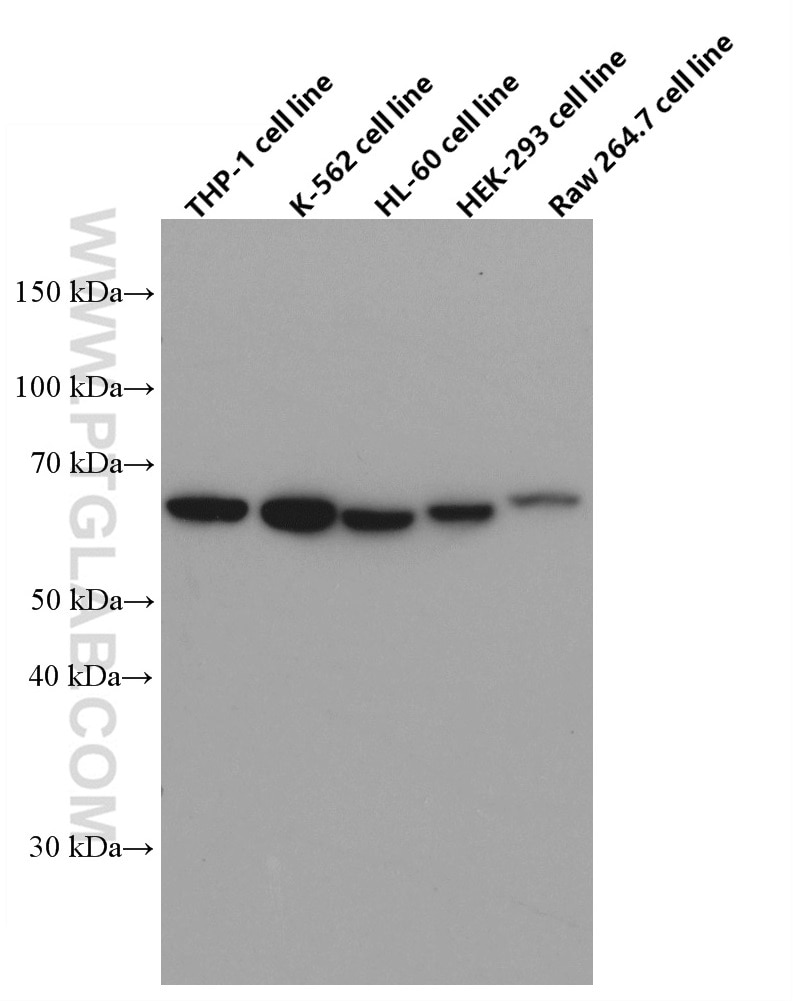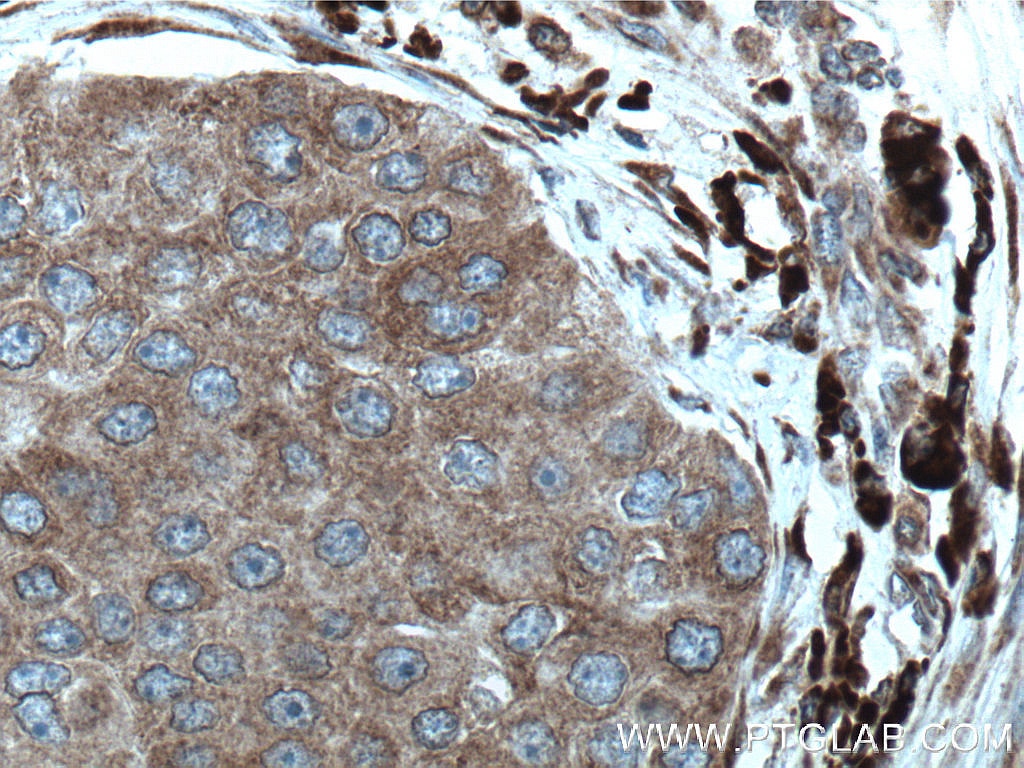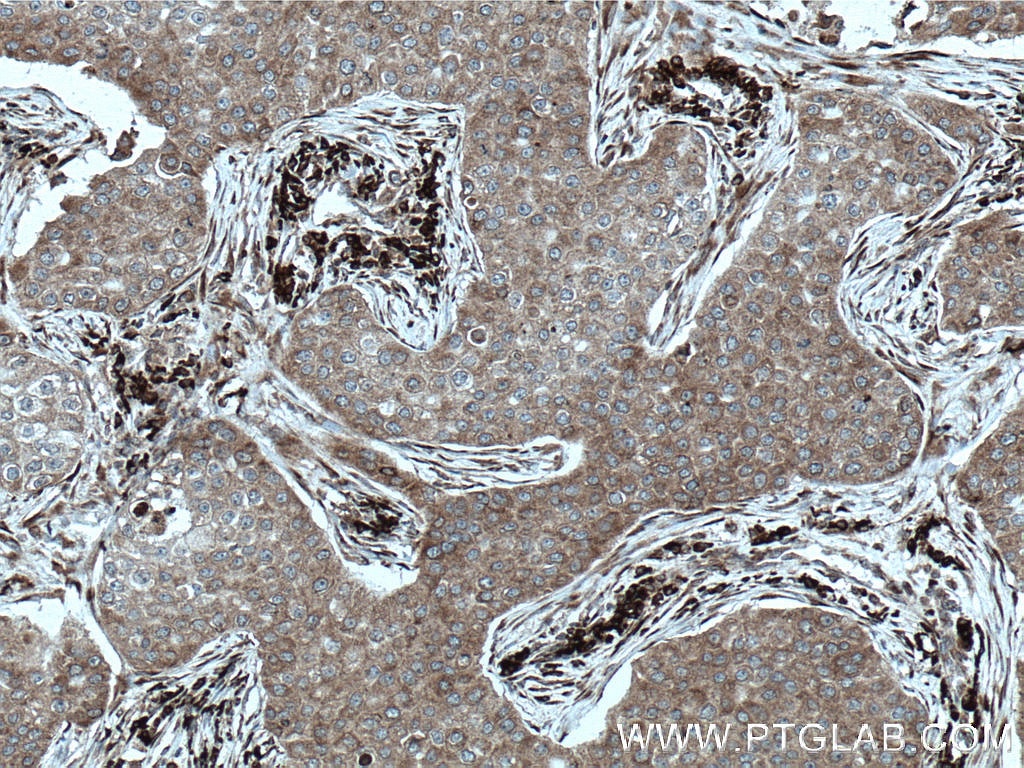- Featured Product
- KD/KO Validated
STT3A Monoklonaler Antikörper
STT3A Monoklonal Antikörper für WB, IHC, ELISA
Wirt / Isotyp
Maus / IgG1
Getestete Reaktivität
human, Maus, Ratte
Anwendung
WB, IHC, IF, ELISA
Konjugation
Unkonjugiert
CloneNo.
1E2B12
Kat-Nr. : 66581-1-Ig
Synonyme
Geprüfte Anwendungen
| Erfolgreiche Detektion in WB | THP-1-Zellen, HEK-293-Zellen, HL-60-Zellen, K-562-Zellen, RAW 264.7-Zellen |
| Erfolgreiche Detektion in IHC | humanes Mammakarzinomgewebe Hinweis: Antigendemaskierung mit TE-Puffer pH 9,0 empfohlen. (*) Wahlweise kann die Antigendemaskierung auch mit Citratpuffer pH 6,0 erfolgen. |
Empfohlene Verdünnung
| Anwendung | Verdünnung |
|---|---|
| Western Blot (WB) | WB : 1:1000-1:6000 |
| Immunhistochemie (IHC) | IHC : 1:50-1:500 |
| It is recommended that this reagent should be titrated in each testing system to obtain optimal results. | |
| Sample-dependent, check data in validation data gallery | |
Veröffentlichte Anwendungen
| KD/KO | See 1 publications below |
| WB | See 2 publications below |
| IHC | See 2 publications below |
| IF | See 2 publications below |
Produktinformation
66581-1-Ig bindet in WB, IHC, IF, ELISA STT3A und zeigt Reaktivität mit human, Maus, Ratten
| Getestete Reaktivität | human, Maus, Ratte |
| In Publikationen genannte Reaktivität | human |
| Wirt / Isotyp | Maus / IgG1 |
| Klonalität | Monoklonal |
| Typ | Antikörper |
| Immunogen | STT3A fusion protein Ag27072 |
| Vollständiger Name | STT3, subunit of the oligosaccharyltransferase complex, homolog A (S. cerevisiae) |
| Berechnetes Molekulargewicht | 705 aa, 81 kDa |
| Beobachtetes Molekulargewicht | 65 kDa |
| GenBank-Zugangsnummer | BC020965 |
| Gene symbol | STT3A |
| Gene ID (NCBI) | 3703 |
| Konjugation | Unkonjugiert |
| Form | Liquid |
| Reinigungsmethode | Protein-G-Reinigung |
| Lagerungspuffer | PBS with 0.02% sodium azide and 50% glycerol |
| Lagerungsbedingungen | Bei -20°C lagern. Nach dem Versand ein Jahr lang stabil Aliquotieren ist bei -20oC Lagerung nicht notwendig. 20ul Größen enthalten 0,1% BSA. |
Hintergrundinformationen
STT3A, also named as Integral membrane protein 1, belongs to the STT3 family. STT3A is expressed at high levels in placenta, liver, muscle and pancreas, and at very low levels in brain, lung and kidney. STT3A is a catalytic subunit of the N-oligosaccharyl transferase (OST) complex which catalyzes the transfer of a high mannose oligosaccharide from a lipid-linked oligosaccharide donor to an asparagine residue within an Asn-X-Ser/Thr consensus motif in nascent polypeptide chains. STT3A is present in the majority of OST complexes and mediates cotranslational N-glycosylation of most sites on target proteins, while STT3B-containing complexes are required for efficient post-translational glycosylation and mediate glycosylation of sites that have been skipped by STT3A. There are two isoforms of STT3A with molecular weight of 81 and 70 kDa. 66581-1-Ig antibody detects a protein around 65-70 kDa in SDS-PAGE which is similar to papers published. (PMID: 32005703, 25135935)
Protokolle
| PRODUKTSPEZIFISCHE PROTOKOLLE | |
|---|---|
| WB protocol for STT3A antibody 66581-1-Ig | Protokoll herunterladen |
| IHC protocol for STT3A antibody 66581-1-Ig | Protokoll herunterladenl |
| STANDARD-PROTOKOLLE | |
|---|---|
| Klicken Sie hier, um unsere Standardprotokolle anzuzeigen |
Publikationen
| Species | Application | Title |
|---|---|---|
Transl Lung Cancer Res Targeting STT3A produces an anti-tumor effect in lung adenocarcinoma by blocking the MAPK and PI3K/AKT signaling pathway. | ||
Front Immunol Analysis of Tumor Glycosylation Characteristics and Implications for Immune Checkpoint Inhibitor's Efficacy for Breast Cancer. | ||
Cancer Lett Pharmacological suppression of HHLA2 glycosylation restores anti-tumor immunity in colorectal cancer | ||
Adv Sci (Weinh) N-glycosylation Modification of CTSD Affects Liver Metastases in Colorectal Cancer
|




